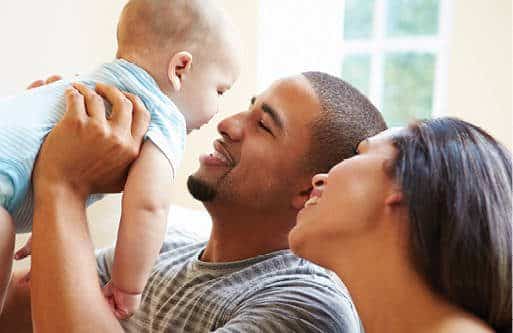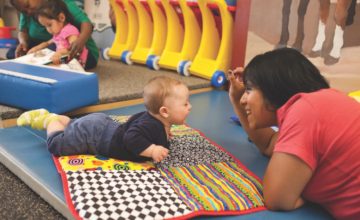Julie A. Larrieu and Charles H. Zeanah, Tulane University School of Medicine

Abstract
DC:0–5™: Diagnostic Classification of Mental Health and Developmental Disorders of Infancy and Early Childhood (ZERO TO THREE, 2016) emphasizes the centrality of relationships for young children’s development and psychopathology. The authors share the story of a young child and his mother to illustrate the use of DC:0–5, with an emphasis on how ratings of the primary caregiving relationships and the caregiving environment are used in the assessment process to create a treatment plan for the child and family.
As a nosology of early childhood disorders, DC:0–5™: Diagnostic Classification of Mental Health and Developmental Disorders of Infancy and Early Childhood (DC:0–5, ZERO TO THREE, 2016) emphasizes the centrality of relationships for young children's development and psychopathology by devoting an entire axis to the caregiving context. DC:0–5 features the explicit statement that understanding the relationship context "should be included in every assessment of infants/young children" (p. 139). Also explicit is that the relationship between caregiving relationships and child psychopathology is bidirectional and that disturbances in the caregiving relationship may arise largely from within the child or the caregiver or from the fit between the two (ZERO TO THREE, 2016).
Though a relationship axis was included in Diagnostic Classification of Mental Health and Developmental Disorders of Infancy and Early Childhood (DC:0--3, ZERO TO THREE, 1994), in DC:0–5, Axis II is substantially revised. First, there is a characterization of the young child's relationship with one or more primary caregivers, and a characterization of the broader caregiving environment. Both primary caregiving relationships and the caregiving environment are to be formally rated using a four-point anchored scale of level of adaptive qualities. Each level includes a range of adaptive functioning: well-adapted to good-enough, strained to concerning, compromised to disturbed, and disordered to dangerous. The scales are ordinal (but not continuous) in that Level 1 is assumed to include the majority of young child--caregiver relationships, designating those that are not in need of clinical focus.
To aid in the clinical assessment of the young child's primary caregiving relationships, the clinician is encouraged to rate 14 separate dimensions of caregiving as "strength," "not a concern," or "concern." Similar ratings are encouraged for seven different child characteristics that call attention to the child's contribution to the relationship (see Tables 1 and 2, p. 14). The clinician is encouraged also to complete similar ratings of eight dimensions of the broader caregiving environment (see Table 3, p. 15).
Another significant change in DC:0–5 is the inclusion of a relationship disorder on Axis I. Building on a large body of research documenting that infants and young children may construct qualitatively different relationships with different adult caregivers and on clinical case reports of relationship specific psychopathology (Zeanah & Lieberman, 2016), the new relationship specific disorder of infancy/early childhood identifies symptomatic behavior in the young child that is restricted to one relationship. As with other disorders in DC:0–5, functional impairment is required to emphasize that the diagnosis is made to identify nontrivial emotional or behavioral disturbances. If diagnostic criteria for relationship specific disorder are met, then the primary caregiving relationship adaptation on Axis II must be rated at Level 3 or 4.
Table 1. Dimensions of Caregiving
Table 2. Infant’s/Young Child’s Contributions to the Relationship
Table 3. Dimensions of the Caregiving Environment
Case of a Killer (To Be)
We present a composite case of a young child and his mother presenting to a clinical setting to illustrate use of DC:0–5, with an emphasis on the relational context ratings. We also illustrate how a relationship formulation makes use of the ratings to help in designing a treatment plan for the child and family.
Clinical Background and Presentation
When we met Nicholas (“Nick”), he was almost 60 months old. Until recently he had lived with his 26-year-old mother, Maria, her fiancé, Earl, and his two younger sisters, Natalie, 42 months and Lulu, 28 months. Nick and his sisters were placed in foster care (in two different foster homes) after Nick reported to his afterschool teacher that his mother had “beat him.” He showed the teacher bruises on his arms. This disclosure led to a Child Protective Services investigation, and a pediatric forensic exam determined that his bruises were suspicious for child abuse. Maria claimed that the bruises were likely from Nick’s babysitter. Nevertheless, all three children were taken into the state’s custody. Following this, Nick, his sisters, and his mother were referred to our clinic for evaluation and treatment, with a goal of reunification. Because his sisters were returned to Maria’s care after only a few weeks in foster care, we are limiting our focus here to Nick.
When we met Nick, he was a bright, energetic, and cooperative child. He had been in care for several weeks, but he seemed comfortable with his foster mother, and she seemed committed to him. She reported that he had seemed frightened and a bit “hyper” when he first came into care, but he had settled into their household routines within a week, and he was having no significant difficulties. He had come back from weekly visits with his mother and siblings and was withdrawn and sometimes sullen for the rest of the day, but he generally had “recovered” the following day. He seemed reluctant to talk with his foster mother about his biological family, and she “gave him space.”
Child Protective Services reported no significant conflicts during visits, other than minor sibling squabbles at times. Reports from preschool were that Nick was cooperative and engaged and had no significant difficulties with his classmates or teachers. In fact, they had noted that he was a bright and curious child who was especially responsive to praise and positive attention. The reports of both his foster mother and the school were congruent with what we noted in our clinic evaluation of him.
Reports from his biological mother, Maria, were strikingly different, however. She reported that Nick was irritable, angry, and violently aggressive with her. Although she acknowledged that he could be quite helpful at times, she believed that when he lost his temper, he became “wild” and unsafe because of his aggression. She also believed that he “lost it” too easily, generally when he didn’t “get his way.”
Taking our own observations and all of these reports into account, we diagnosed him with relationship specific disorder of infancy/early childhood, because his irritability and aggression were limited exclusively to his relationship with his mother.
Maria’s Background
Maria’s history was one of family instability, traumatic experiences including childhood abuse, and witnessing the shooting death of Natalie’s biological father. Maria lived with her mother and father until she was 40 months old, when they divorced. She remained in the home with her mother until 66 months, at which time she moved in with her father. When her father remarried 5 years later, Maria moved to her aunt’s home. At 16 years old, her aunt could no longer care for her due to chronic illness, and Maria returned to live with her Understanding the relationship context should be included in every assessment of infants/young children. mother. They had significant ongoing conflicts, and soon Maria was emancipated. Maria attended counseling for depression when she was an adolescent and again following the murder of Natalie’s father, although she only had one session of “grief work” before discontinuing the treatment. Maria received no other mental health services to assist her with this trauma or any of her previous losses or traumatic experiences.

Understanding the relationship context should be included in every assessment of infants/young children. Photo: Vaillery/shutterstock
Maria reported having experienced multiple violent relationships with men as an adolescent and young adult. She reported having been beaten, choked, and burned. She stated that Nick had witnessed family members physically fighting, hitting, slapping, kicking, and pushing each other, and seeing her former boyfriend arrested. She stated that both she and Nick had been told repeatedly that they were worthless, they had been yelled at in a frightening manner, and they had been threatened with physical assault by her former boyfriend brandishing a weapon. Maria reported that she found Nick to be a difficult child to parent and she did not find that being a parent to Nick was rewarding.
Relationship Assessment: Maria and Nick
Our approach to relationship assessment included both an interview to assess the parents’ representation of their child and an observational assessment of how they interacted together in more and less structured activities (Larrieu et al., 2019). To assess Maria’s perceptions of Nick, and her subjective experience of him, we administered the Working Model of the Child Interview (Larrieu et al., 2014). To assess their pattern of interacting, we administered the Crowell Parent Child Interactional Procedure (see Larrieu et al., 2019).

Infants and young children may construct qualitatively different relationships with different adult caregivers. Photo: Monkey Business Images/shutterstock
In the Working Model of the Child Interview, Maria demonstrated significant distortions about Nick’s personality and concerning expectations about their relationship. During her pregnancy, she had been sure she was having a boy, and she imagined that he would be “the man in my life—my protector.” Postnatally, she described him as threatening, dangerous, and powerful. She gave detailed examples throughout the interview of Nick as aggressive, callous, and sadistic. These perceptions were strongly colored by her experiences with two important men in his life: his biological father and a previous boyfriend, both of whom had been violent with her. When asked to describe Nick’s personality, Maria stated that Nick was “very angry, keeps stuff bottled inside and later lashes out, but is exceptionally intelligent, just like his father.” When asked to choose adjectives that describe Nick’s personality, Maria chose “angry,” “intelligent,” “mischievous,” “protector,” and “strong.” She provided specific examples to illustrate these attributes. For example, for the word “angry,” Maria stated,
I can say the least little bitty thing and he goes off...goes to fighting, goes to kicking.... First, it starts with being aggressive with your siblings—he’s done that. Then, you go to animals—Nick has killed a hamster. The next thing is to really try to hurt someone. I don’t understand anger like that, that’s evil anger, like Freddy Kreuger.
To illustrate “protector,” she said, “He helps with his little sister. He’s been doing that, in terms of protecting and providing.” When asked what makes Nick unique compared to other children his age, Maria responded that “he is smart, and he recognizes things that other children his age do not recognize. He’s so great with responsibility—he won’t buckle under pressure like I do.”
When asked if Nick had had any experiences that may have been setbacks for him, Maria replied “I think that babies understand when their momma gets hit, and Nick saw my (previous) boyfriend hit me. Now that is how he [Nick] thinks he can get his way with me.” Asked if she were able to start over, knowing what she knows now, Maria replied she would have “left the first time my (previous) boyfriend hit me in front of Nick and gone home to my daddy.”
It was clear that twin themes dominated her representation of Nick. On the one hand, she experienced him as violent, dangerous, and unpredictable—a remorseless and sadistic aggressor, like a killer in a slasher movie. While focusing on Nick’s dangerous characteristics in the interview, Maria predicted Nick would grow up and “kill somebody or be killed” by the time he was 13 years old. On the other hand, she also experienced him as a strong, responsible, and benevolent protector. She gave examples of their special closeness, his helping her with his younger siblings (“way more than other children his age”) and his attempts to please her. It was unclear whether she maintained these disparate images simultaneously or whether they alternated in rapid shifts in her mind. She described selecting his name to mean “victorious warrior of the people,” though when we checked, it seemed that she had added “warrior” to the conventional meaning.
It was clear that Maria’s perceptions of Nick were largely rooted in her past traumatic experiences with his biological father, who was serving a life sentence for violent crimes, as well as her experiences with a previous boyfriend. Each of these relationships were characterized by serious violence, men she saw as dangerous and unpredictable as well as powerful and protective.
Her involvement with men who were violent was a pattern throughout her adult life. Maria repeatedly expressed her fear that Nick would become increasingly violent as he grew older and feared that, as a result, he would have a shortened life span. She stated that Nick reminded her most of his biological father because of the angry outbursts that he had. She was able to comment positively on Nick’s intelligence and his ability to understand how to make her feel better. Throughout the interview, Maria consistently recounted incidents and memories in which Nick met her emotional needs. She described Nick as her “protector.”
In the Crowell Parent Child Interactional Procedure, which involves episodes of play, clean up, bubbles, teaching tasks, and a brief separation and reunion, Maria and Nick displayed a strong emotional connection. Maria showed some playfulness with Nick during the procedure, and they had some early moments of cooperation, such as when she requested per our instructions that he clean up the toys. Early on, Maria praised Nick’s efforts, and he grinned broadly in response.
Although free play involved a good bit of laughing together and seemed enjoyable on the surface as Nick played “the doctor” and examined his mother, there also was an undercurrent of tension as she laughingly teased and challenged him, alternating between needing him to take charge and then implying he was not up to the job.
Their interaction deteriorated precipitously in the first of two teaching tasks. The task was for Nick to identify matches of cards that were turned over by remembering where they were placed. After he made an incorrect selection, Nick peeked under another overturned card. Maria immediately chastised him, calling him a cheater and saying she didn’t like cheaters.
Nick, wounded by her words, retreated across the playroom and began to sulk, rocking back and forth. Maria several times used a cajoling or pleading tone to entice him to return to play. “Come back and play with me, Nick.” Later, she said, “Come back my baby—come back, Momma baby.” Nick, seeking to save face, responded, “Let’s start all over again,” as he began to approach her. But his appeal to “start over” triggered an additional barrage of criticism from his mother. Using a stern voice, she told him that he was a poor sport and that he was a crybaby and a cheater and that she did not like to play with cheaters. Maria also told Nick, “How would you like it if every time you beat me up or cursed me or something, I cried and left you alone?” Nick declined to answer and resumed the task. Mom taunted him, “Ha ha, you lost,” and Nick grunted in response. Mom asked him, “You don’t like me or something?” Nick furrowed his brow and growled.
Their struggle continued in the next task with repeated opportunities for repair missed. Nick wanted to return to the prior task, but his mother insisted that he could not and that he had to engage in the current task. He began to whine, “No, I don’t,” but she then began to provoke him with insistent “Yes, you do,” each time he said, “No, I don’t.” Finally, Nick growled angrily. Maria asked him if he was mad, and Nick acknowledged that he was. Still, soon they were arguing about whether he “wanted to play” with his mother. He plaintively insisted that he did want to play with her, but she responded again by lashing out angrily about how when he had the chance, he instead chose to play by himself. “You were cheating and didn’t want to play with me,” she said accusingly. “See, you’re always playing ugly, and I am trying to play fair.” She added, “You can’t always have your way. You’re going to end up seriously hurting someone, son.”
Relationship Assessment Summary
Nick and Maria had strengths evident in their relationship. Most important, they had an intense connection, each feeling that the other was important and that their relationship mattered. Each partner brought strengths to their relationship. Maria was bright and insightful at times, and she clearly wanted a positive connection with Nick. In part to her credit, Nick’s physical appearance, health, developmental status, and temperamental disposition all were strengths, as was his pleasure in pleasing others (see Table 2). There were moments of mutual enjoyment and fun in their interaction, cooperation during some endeavors, and even an instance of Maria having Nick express his feelings. Each expressed a yearning for repair but felt it unreciprocated. Maria’s descriptions of Nick were specific and detailed, and they conveyed her considerable psychological engagement with him. Her relationship with Nick seemed to matter a great deal to her.
These relationship strengths were overwhelmed by the intense conflict and pain that Nick and Maria each experienced and by their hostile behavior with one another. Maria had difficulty with all aspects of caregiving that required her to appreciate Nick’s perspective, especially setting firm, consistent limits, communicating clearly, and her penchant for harshness and criticism (see Table 1). Maria expected too much of Nick: to function well beyond his age (e.g., understanding how to accomplish difficult tasks with little instruction from her); to regulate his feelings and behavior, even in the face of her provocative behaviors; and to anticipate and follow her rules. She also indicated he was responsible for being in foster care because of his behavior rather than her own actions in not protecting him. When Nick resisted his mother’s attempts, she taunted or chided him, and he then angrily lashed out.

Relationships between young children and their caregivers are a central focus of infant mental health. Photo: Monkey Business Images/shutterstock
Relationship With Primary Caregiver Rating
The DC:0–5 rating of the adaptive quality of the primary caregiving relationship for Nick and Maria is Level 4, disordered to dangerous. According to DC:0–5, relationships at this level
convey an unquestionable urgency about the need to intervene to address serious and potentially dangerous relationship qualities. Not only are adaptive qualities lacking, but the relationship pathology is severe and often pervasive, with impairments in the dyad’s capacity to engage in adequate protection, emotional availability and emotion regulation; expressing and responding to needs for comfort and caregiving; as well as support for and willingness to engage in age-appropriate exploration and learning. The relationship may be fraught with significant overt conflict, seriously insufficient engagement much of the time, or significant role reversal. Parental attributions regarding the infant/young child are negative, demonstrate significant developmentally inappropriate expectations, and are not open to reflection or challenge. These disturbances are seriously compromising the infant’s/young child’s development or may threaten the infant’s/child’s physical or psychological safety (pp. 144–145).
Although we noted some adaptive qualities in the relationship between Maria and Nick, the severity of their conflict and Maria’s harsh criticism that approached emotional abuse made the rating clear.
Broader Caregiving Environment
Because he was in foster care, Nick had two additional caregiving environments to consider. Ratings for each of these are included in Table 3. First, his relationship with his foster parents (and especially foster mother) was quite helpful to him. She was warm but also structured and organized. She understood his situation and did an excellent job of being supportive and encouraging while also supporting Nick’s relationship with his mother and family. The caregiving environment she provided was rated as Level 1 — well-adapted to good-enough. Nick’s foster parents functioned well and demonstrated strengths in all caregiving dimensions. Second, the caregiving environment that included Earl and Maria, and their relationship with each other and the family relationships that included Natalie and Lulu, were also mostly positive. Maria’s relationship with Earl was nonviolent, and, by her descriptions, was the healthiest romantic relationship she had ever had. They seemed to be comfortable with one another and on the occasions when we met with him, he was a calm and supportive presence for Maria. Nick was a bit threatened by this relationship—no doubt he feared losing his special if deeply unhealthy position as his mother’s “provider and protector.” We assessed the caregiving environment provided by Earl and Maria as Level 1 — well-adapted to good-enough, based on their adequate management of caregiving functions, communication, roles, resolution of disagreements, and the positive relationships among the siblings. We planned to monitor their problem-solving and skills in regulating behavior, and as needed, work with them on these caregiving responsibilities.
Child–Parent Relationship Formulation
The relationship assessment we conducted indicated that Maria and Nick had a relationship marked by intensity and caring but also misunderstandings, inappropriate expectations, role reversal, and reenactments of Maria’s prior traumatic experiences. Perhaps most striking about Maria’s representation of Nick was the experience of him as dangerous and threatening on the one hand but responsible and protective on the other. There was no evidence that these disparate images of Nick were integrated into a nuanced view— instead, they succeeded one another often in rapid succession. Further, Maria’s behavior with Nick played out these twin themes, as she alternated being helpless (needing him to protect her) and hostile (derogating him). What united these disparate images is that they both imbued Nick with powers well beyond his age, creating enormous psychological pressure on him. Her provocative behavior frustrated him to the point that he became angry and aggressive, thus validating her perception of him as dangerous and threatening and justifying her withering attacks that belittled him. Her solicitous behavior led him to want to please but also to take charge in a way that was impossible for a preschool child, poignantly striving to “protect and provide” as she had imagined during her pregnancy. This led to some conflicts with his mother and her fiancé, whom Nick felt was a threat to his special relationship with his mother.
We understood that Maria had internalized a relationship pattern that was intense and included one component that was powerful and dangerous and another that was helpless and vulnerable. We presumed that her engaging in these patterns with Nick was a reenactment of previous relationships she had had with violent partners in her past. Her provocative behavior with Nick represented identification with the aggressor, a defense against feelings of helpless terror that she had no doubt experienced in many previous intimate relationships.
Nick experienced Maria as needing him but also as dangerous. In their interactions, he was learning to associate neediness with danger—being aware of his own neediness would thus be too threatening and need to be kept out of awareness. As he grew up, we feared that he would be drawn into relationships that would perpetuate the cycle by experiencing overwhelming rage followed by remorseful submission and neediness, thus recapitulating the disordered relationship pattern.
The broader caregiving contexts were somewhat hopeful in this case. We believed that the strengths we identified both in Nick’s relationship with his foster mother and the caregiving environment within his biological family were useful to draw upon as we worked on his relationship with Maria.
Discussion
Relationships between young children and their caregivers are a central focus of infant mental health. It is widely accepted that one of the important contributions that caregivers make to infants and young children is to regulate their emotions and behaviors (Sameroff & Emde, 1989). Over the first several years, infants and toddlers internalize those experiences and begin to assume more control over their emotions and behaviors. The importance of self-regulation in early childhood is underscored by research indicating that self-control in early childhood predicts long-term adaptation. For example, in the well-known Dunedin Multidisciplinary Health and Development Study, investigators found that self-control assessed by laboratory observation in 3- to 5-year-olds predicted health, wealth, criminal behavior, and substance use at 32 years old (Moffit et al., 2011).
In the case of Nick, self-control was quite problematic in the context of interacting with his mother, but he retained reasonable self-control in other settings. This discrepancy made the diagnosis of relationship specific disorder of infancy/ early childhood clear and also created a sense of urgency to enhance his disturbed relationship with his mother to prevent broadening of his maladaptive behaviors to other settings. Using Axis II of DC:0–5, we systematically assessed the strengths and concerns of his primary caregiving relationship and his broader caregiving environment. This assessment provided valuable additional information to understand his functioning and symptomatology and allowed us to develop a treatment plan designed to enhance his functioning by changing the nature of his relationship with Maria. We surmised that positive changes in the mother–child relationship would also enhance the broader caregiving environment and further strengthen its protective effect.
Author Bios
Julie A. Larrieu, PhD, is a professor of psychiatry at Tulane University School of Medicine. Dr. Larrieu’s clinical and research interests focus on infant mental health, developmental psychopathology, and training issues. Most of her work deals with abuse and neglect of infants and toddlers, including identifying risk factors for abuse, as well as predictors of successful treatment for parents who have maltreated their children. She provides training in infant mental health to professionals who are skilled in working with school- age children, and to public health nurses who work with a variety of at-risk families. Dr. Larrieu is an endorsed national and international trainer for child–parent psychotherapy, an evidence-based intervention for children from birth to 6 years old who have experienced trauma and interpersonal loss, and their caregivers.
Charles H. Zeanah, MD, is Mary Peters Sellars Polchow Chair of Psychiatry, a professor of psychiatry and pediatrics, and Vice Chair for Child and Adolescent Psychiatry in the Department of Psychiatry and Behavioral Sciences at Tulane University School of Medicine. He is also the director of the Institute of Infant and Early Childhood Mental Health. Dr. Zeanah is a former board member of ZERO TO THREE. Dr. Zeanah’s major academic interest has been in the area of infant mental health and adverse early experiences. He conducts research on the effects of abuse, neglect, serious deprivation, and exposure to violence on young children and on interventions designed to help them recover. He has also studied approaches to understanding and classifying disorders of early childhood, especially disorders of attachment and posttraumatic stress disorder.
Suggested Citation
Larrieu, J. A., & Zeanah, C. H. (2021). Relational context and relational psychopathology in early childhood: An illustration of the DC:0–5 approach. ZERO TO THREE Journal, 42(2), 13–19.
References
Larrieu, J. A., Middleton, M., Kelley, A., & Zeanah, C. H. (2019). Assessing the relational context of infants and young children. In C. H. Zeanah (Ed.), Handbook of infant mental health, (4th ed., pp. 279–295). Guilford Press.
Larrieu, J. A., Stevens, M., & Zeanah, C. H. (2014). The Working Model of the Child Interview. In S. Farnfield & P. Holmes, (Eds.), The Routledge handbook of attachment: Assessment (pp. 133–143). Routledge.
Moffit, T., Arsenault, L., Belsky, D., Dickson, N., Hancox, R. J., Harrington, H., Houts, R., Poulton, P., Roberts, B. W., Ross, S., Sears, M. R., Thomson, W. M., & Caspi, A. (2011). A gradient of childhood self-control predicts health, wealth, and public safety. Proceedings of the National Academy of Science, 108, 2693–2698.
Sameroff, A. J., & Emde, R. N. (Eds.). (1989). Relationship disturbances in early childhood: A developmental approach. Basic Books.
Zeanah, C. H., & Lieberman, A. F. (2016). Defining relational pathology in early childhood: The Diagnostic classification of mental health and developmental disorders of infancy and early childhood DC:0–5 approach. Infant Mental Health Journal, 37, 509–520.
ZERO TO THREE. (1994). Diagnostic classification of mental health and developmental disorders of infancy and early childhood.
ZERO TO THREE. (2016). DC:0–5TM: Diagnostic classification of mental health and developmental disorders of infancy and early childhood.




